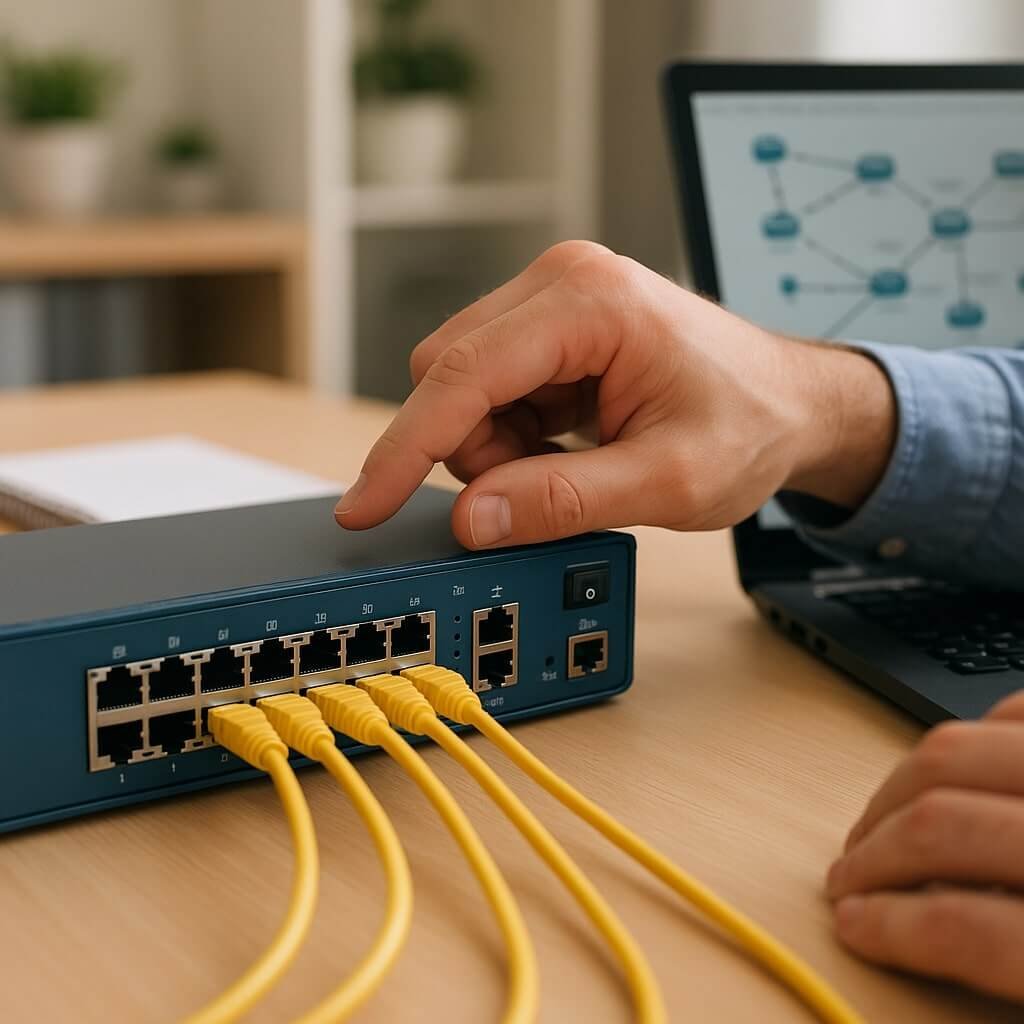A secure network protects sensitive information from unauthorized access and cyber threats. It employs technologies such as encryption and firewalls to guarantee data integrity and confidentiality. As cyber threats evolve, understanding the components and importance of network security becomes essential for safeguarding your organization. What are the key elements that make a network secure, and how can you practically implement them to mitigate risks?
Key Takeaways
- A secure network protects sensitive data from unauthorized access and cyber threats, ensuring data integrity and confidentiality.
- It employs encryption protocols like HTTPS and SSL/TLS to secure data during transmission.
- Regular updates, access controls, and firewalls are crucial components in mitigating vulnerabilities and regulating network traffic.
- Network security is essential to prevent data breaches, which can result in significant financial loss and reputational damage.
- Compliance with privacy regulations is critical, underscoring the need for robust security measures in organizations.
Defining a Secure Network
A secure network is a digital fortress designed to protect sensitive data from unauthorized access and cyber threats. To achieve this, it employs secure protocols that encrypt data during transmission, ensuring only authorized users can access it.
These protocols, such as HTTPS and SSL/TLS, create a protective layer over your communications. In addition, network segmentation plays an important role in enhancing security. By dividing the network into smaller, isolated segments, you limit potential attack vectors and contain breaches if they occur.
This strategy not only improves data security but also optimizes performance by reducing congestion. As a result, understanding secure protocols and network segmentation is essential for establishing a robust, secure network that safeguards your critical information against evolving cyber threats.
Key Components of a Secure Network
To establish a secure network, you need to implement critical components such as firewalls, intrusion detection systems, and robust encryption methods.
Regularly updating security protocols and applying patches is essential to protect against vulnerabilities.
Firewalls and Intrusion Detection
While many elements contribute to a secure network, firewalls and intrusion detection systems (IDS) stand out as critical components that actively protect against unauthorized access and malicious activity.
Firewalls serve as the first line of defense, enforcing strict firewall configurations to regulate incoming and outgoing traffic based on predetermined security rules. By filtering data packets, they prevent unauthorized access while allowing legitimate traffic.
Intrusion detection systems complement firewalls by monitoring network traffic for suspicious behavior. They provide intrusion prevention capabilities, detecting and responding to threats in real time.
Together, these tools form a robust security framework, ensuring that potential breaches are identified and mitigated swiftly, maintaining the integrity and confidentiality of your network.
Encryption and Authentication Methods
As the backbone of secure communications, encryption and authentication methods play an essential role in safeguarding sensitive data from unauthorized access.
You need to implement robust encryption algorithms, such as AES or RSA, to guarantee that data remains confidential during transmission. These algorithms convert plaintext into ciphertext, rendering it unreadable to interceptors.
Similarly, utilizing strong authentication protocols, like OAuth or Kerberos, verifies user identities and establishes trust before granting access to sensitive information.
By combining these two key components, you create a secure network environment that protects against data breaches and cyber threats.
Regular Security Updates and Patches
Even with strong encryption and authentication methods in place, a secure network relies heavily on the timely application of regular security updates and patches.
You should prioritize update frequency to guarantee vulnerabilities are addressed promptly. Cyber threats evolve continuously, and software developers regularly release security patches to combat newly discovered exploits.
Failing to apply these updates exposes your network to potential breaches, as attackers often target outdated systems. Establish a routine for monitoring and implementing updates, integrating automated tools where possible to streamline the process.
Regularly assess your network’s security posture to identify any gaps that may arise from delayed patching. Remember, a proactive approach to updates is essential for maintaining a robust and secure network environment.
Common Cyber Threats
Understanding common cyber threats is essential for maintaining secure networks, given the ever-evolving landscape of digital vulnerabilities.
As you navigate this terrain, be aware of the following threats:
- Phishing scams: Deceptive emails trick you into revealing sensitive information.
- Malware attacks: Malicious software can infiltrate your systems, causing severe damage.
- Ransomware threats: Cybercriminals encrypt your data, demanding payment for its release.
- Insider threats: Employees may intentionally or unintentionally compromise your network’s security.
Additionally, social engineering tactics can manipulate you into disclosing credentials, while denial of service attacks can overwhelm your network.
Data breaches expose sensitive information, leading to potential credential theft. Recognizing these threats is vital in fortifying your defenses.
The Importance of Network Security
Network security is vital for protecting sensitive information from breaches that can compromise both personal and organizational data.
By implementing robust security measures, you can effectively prevent unauthorized access and mitigate the risk of cyber threats.
Understanding the importance of these protections is essential for maintaining the integrity of your network.
Protecting Sensitive Information
While organizations increasingly rely on digital platforms to store and transmit sensitive information, the need for robust network security has never been more critical.
Data breaches can lead to devastating consequences, not just financially but also regarding reputation and compliance with privacy regulations. You must prioritize security measures to mitigate these risks.
Consider the emotional impact of a breach:
- Loss of customer trust
- Legal repercussions and fines
- Damage to brand reputation
- Emotional distress for affected individuals
Preventing Unauthorized Access
To guarantee the integrity of your organization’s data, it’s vital to implement stringent measures that prevent unauthorized access. Unauthorized access prevention relies heavily on effective access control mechanisms.
These mechanisms define who can access your network and what resources they can utilize. By implementing role-based access controls, you can ascertain that only authorized personnel can access sensitive information, reducing the risk of data breaches.
Additionally, multifactor authentication adds an extra layer of security, making it more difficult for unauthorized users to gain entry. Regularly auditing access permissions helps you identify and revoke unnecessary access rights, further minimizing vulnerabilities.
Ultimately, robust unauthorized access prevention strategies are essential for maintaining a secure network and protecting your organization’s critical assets.
Best Practices for Securing Your Network
Securing your network requires a multi-faceted approach, as vulnerabilities can arise from various sources.
To effectively protect your network, consider implementing these best practices:
- Regular Network Monitoring: Keep an eye on traffic patterns and anomalies to quickly detect threats.
- User Education: Train employees on security protocols and phishing awareness to reduce human error.
- Strong Password Policies: Enforce complex passwords and regular updates to minimize unauthorized access risks.
- Firewall and Security Software: Utilize advanced firewalls and antivirus solutions to create robust barriers against potential attacks.
Future Trends in Network Security
As organizations continue to adapt to evolving threats, the future of network security is shaped by emerging technologies and innovative strategies.
Quantum encryption is set to revolutionize data protection by utilizing the principles of quantum mechanics, making it nearly impossible for unauthorized entities to intercept communications. This technology will enhance confidentiality and integrity in data transfers.
Simultaneously, AI-driven security solutions are becoming increasingly essential. These systems analyze vast amounts of data in real-time, identifying patterns and anomalies that signal potential breaches.
Conclusion
In summary, understanding what a secure network is and its critical role in safeguarding sensitive information is crucial for any organization. By implementing key components like encryption and firewalls, and staying vigilant against common cyber threats, you can greatly reduce risks. Adopting best practices for network security not only protects your data but also guarantees compliance with privacy regulations. As cyber threats evolve, staying ahead of future trends will be imperative for maintaining robust network defenses.






